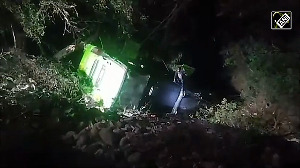The confusion, which prevailed in Pakistan following alleged Al Qaeda kingpin Khalid Sheikh Mohammad's arrest, has now somewhat been cleared. Consequently, a more meaningful analysis is possible despite there being many unanswered questions.
The confusion gave rise to two kinds of speculation:
- That Mohammad was killed during the encounter in Karachi on September 11, 2002, during which Ramzi Binalshibh, another Al Qaeda operative, was captured, hence there had been incorrect identification. This has been proved incorrect by his being handed over to the US.
- That he was actually captured on September 11, but Pakistani officials had shown him as captured on March 1, 2003, in order to soften US anger due to their ambivalent stand on the Iraq issue. This did not stand scrutiny either. If this was really so, the Pakistanis would have stage-managed a raid at some place near the Pakistan-Afghan border and shown him as being arrested there. They would not have shown him as being arrested in Rawalpindi in an area where many serving and retired officers of the army and Inter-Services Intelligence live, which was bound to create suspicion among the Americans about the complicity of military officers with Mohammad.
After studying reports emanating from Pakistan, my assessment is at the behest of American officials, the ISI raided a Jamaat-e-Islami leader's home in Rawalpindi hoping that the American information about his presence there would be wrong. To their shock, they found Mohammad there. This is purely my assessment and I do not have any evidence to prove it.
What next?
The US media is full of reports about valuable documents giving the names and telephone numbers of Al Qaeda sleepers in the US supposedly found at the place of arrest. Details of a follow-up action memorandum alleged to have been issued by the Federal Bureau of Investigation have also been published. One should for the present treat these reports with reservation. These seem to be inspired leaks to remove any suspicion in the minds of the American public about the real significance of the arrest in the war against terrorism.
The arrest and its sequel have corroborated what Indian officials and I have been saying for months, namely that:
- The surviving dregs of Al Qaeda, the Taliban and other components of Osama bin Laden's International Islamic Front escaped into Pakistan from Afghanistan early last year and have been given shelter there.
- While the dregs of the Taliban have taken shelter in the tribal areas of Balochistan, the North-West Frontier Province and the Federally-Administered Tribal Areas, those of Al Qaeda have spread themselves out into the urban areas of Sindh and Punjab. The dregs of the Pakistani components of the IIF have taken shelter in Karachi, Pakistan-occupied Kashmir and the Northern Areas.
- Reports in August 2002 indicated that bin Laden himself was undergoing treatment at the Binori madrassa in Karachi for a sharpnel injury sustained after the American attack on the Tora Bora caves.
These reports were not taken seriously by the Americans earlier. They apparently suspected them to be motivated Indian propaganda. It is hoped that at least now they would take them more seriously and step up pressure on Islamabad to take effective action against the dregs.
The speculation in Pakistan whether Moahammad was really arrested has petered out and replaced by equally frenzied speculation about bin Laden's fate. General Pervez Musharraf, who earlier pooh-poohed reports of his being alive and in Pakistan, now admits grudgingly that he is alive, but still denies he is in Pakistani territory. There is palpable nervousness in Pakistani official circles that he may ultimately be found in their territory, thereby adding to American suspicions about their links with Al Qaeda.
Many in Pakistan are now convinced that the US net is closing in on bin Laden and that he cannot escape capture by the Americans unless he commits suicide. Did bin Laden suspect that the US is close on his heels? Since November 12, 2002, a number of statements attributed to him have been circulating in the Islamic world. In one of them, he was quoted as expressing the hope/fear that he might 'martyr' himself this year and might end up in the belly of the eagle. Many Muslims interpreted the expression 'belly of the eagle' as a reference to the US. Some of them also saw this as possibly a reference to a major terrorist attack planned against the US in which bin Laden might participate. Another possible interpretation is that his statement reflected anxiety that he might not evade capture for long.
The Jamaat's complicity with Al Qaeda should be a matter of concern. Of all the Islamic political parties in Pakistan, the Jamaat has always been the most favoured by the military-intelligence establishment. Its leaders are perceived in Pakistan as the army's blue-eyed mullahs. While maintaining an overtly anti-establishment line, it has always covertly collaborated with the army and ISI. Many Pakistani army officers and nuclear scientists gravitate towards the Jamaat after retirement.
Worrisome examples are those of Lieutenant General Hamid Gul and Lt Gen Javed Nasir, both former directors general of the ISI, and A Q Khan, the 'father' of the Pakistani atomic bomb. It is likely the Jamaat leader gave Mohammad shelter at the behest of retired officers who have been helping Al Qaeda and the Taliban escape decimation by the Americans.






 © 2025
© 2025